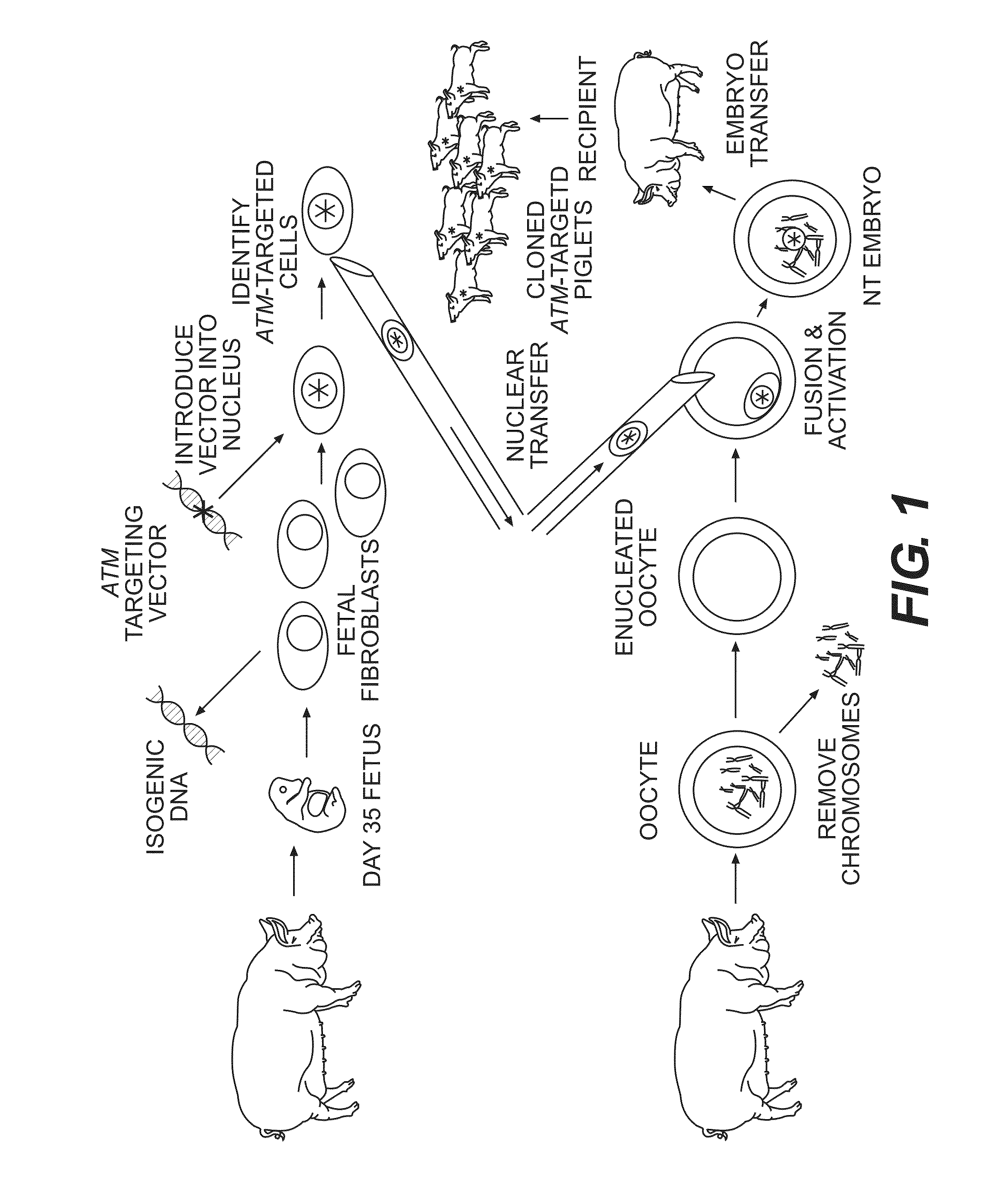Animal Models of Ataxia-Telangiectasia (A-T)
- Summary
- Abstract
- Description
- Claims
- Application Information
AI Technical Summary
Benefits of technology
Problems solved by technology
Method used
Image
Examples
experimental examples
Example 1
Yucatan Miniature Pigs and Cells for Gene Targeting
[0081]The Yucatan miniature pig was selected for development of an ATM model. While it possesses the same biological characteristics as domestic pigs, the Yucatan miniature pig is significantly smaller. Most domestic pig breeds reach 100 kg in less than six months and can achieve weights of 250-300 kg within a few years. Yucatan miniature pigs reach a full-grown size of 65-90 kg at two years of life, which is more similar to an adult human. Therefore, the Yucatan miniature pigs are less expensive to house and feed. Additionally, this breed is more docile in nature and better suited for interactions with researchers. See, e.g., Panepinto, L. M., et al., Lab Anim Sci 1986, 36 (4), 344-7.
[0082]Due to the lack of suitable porcine embryonic stem cell lines, the standard methods for producing gene-targeted mice are not applicable in pigs (Piedrahita, J. A., Theriogenology 2000, 53 (1), 105-16). Instead, gene targeting must be ach...
example 2
Creation of an ATM Targeting Construct
[0083]As mentioned above, porcine ATM has been sequenced and annotated, and the genomic structure is similar to the human gene. Homologous recombination was used to disrupt the endogenous ATM gene. Specifically, a neomycin-resistance cassette (NeoR) was inserted into exon 57 of porcine ATM (FIG. 2). Exon 57 encodes a significant portion of the ATP-binding region within the kinase domain and it is known that a similar strategy to target ATM exons 57 and 58 in mice abolished ATM function (Herzog, K. H., et al., Science, 1998. 280(5366): p. 1089-91). A premature termination codon was also engineered immediately upstream of the NeoR insertion. This strategy was adopted to maximize the likelihood of a non-functional ATM.
[0084]A plasmid carrying the ATM targeting vector was generated using standard molecular biology techniques. Proper sequence was confirmed by DNA sequence analysis. The plasmid was then submitted to the University of Iowa Gene Transfe...
example 3
Targeting ATM in Porcine Fetal Fibroblasts
[0085]Approximately 1.5×106 Yucatan miniature pig fetal fibroblasts—both male and female—were infected with rAAV1 (MOI≅100,000) carrying the ATM targeting vector. After 24 hours, cells were transferred to a series of 96-well plates and G418 (100 μg / ml) was added to the media for selection of targeted cells. Fourteen days later, surviving cells were observed in 20-40% of wells, and each well of the 96-well plates were “replicated” by splitting among three plates: 1) 96-well culture plates for cell expansion, 2) 96-well culture plates for potential cryopreservation, and 3) 96-well PCR plates for cell lysis.
[0086]Cell lysates were screened by PCR to identify wells containing gene-targeted clones and any PCR-positive clones were frozen. (See FIGS. 3A and 3B). The PCR reaction contained two primer pairs—one pair amplified only the properly targeted ATM allele, the other amplified a portion of the porcine LDLR gene as an internal PCR control. PCR ...
PUM
| Property | Measurement | Unit |
|---|---|---|
| Biological properties | aaaaa | aaaaa |
Abstract
Description
Claims
Application Information
 Login to View More
Login to View More - R&D
- Intellectual Property
- Life Sciences
- Materials
- Tech Scout
- Unparalleled Data Quality
- Higher Quality Content
- 60% Fewer Hallucinations
Browse by: Latest US Patents, China's latest patents, Technical Efficacy Thesaurus, Application Domain, Technology Topic, Popular Technical Reports.
© 2025 PatSnap. All rights reserved.Legal|Privacy policy|Modern Slavery Act Transparency Statement|Sitemap|About US| Contact US: help@patsnap.com



